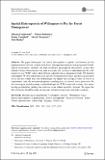Files in this item
Spatial heterogeneity of willingness to pay for forest management
Item metadata
| dc.contributor.author | Czajkowski, Mikołaj | |
| dc.contributor.author | Budziński, Wiktor | |
| dc.contributor.author | Campbell, Danny | |
| dc.contributor.author | Giergiczny, Marek | |
| dc.contributor.author | Hanley, Nick | |
| dc.date.accessioned | 2016-07-22T16:30:06Z | |
| dc.date.available | 2016-07-22T16:30:06Z | |
| dc.date.issued | 2017-11 | |
| dc.identifier | 244483435 | |
| dc.identifier | 7e5d78a1-b5d7-4145-a52e-f65a15bdbf1b | |
| dc.identifier | 84978152381 | |
| dc.identifier | 000415818900012 | |
| dc.identifier.citation | Czajkowski , M , Budziński , W , Campbell , D , Giergiczny , M & Hanley , N 2017 , ' Spatial heterogeneity of willingness to pay for forest management ' , Environmental and Resource Economics , vol. 68 , no. 3 , pp. 705-727 . https://doi.org/10.1007/s10640-016-0044-0 | en |
| dc.identifier.issn | 0924-6460 | |
| dc.identifier.uri | https://hdl.handle.net/10023/9197 | |
| dc.description | This study was carried out as a part of the POLFOREX project (“Forest as a public good. Evaluation of social and environmental benefits of forests in Poland to improve management efficiency”; PL0257) funded by EEA Financial Mechanism, Norwegian Financial Mechanism and Polish Ministry of Science and Higher Education. Funding support is gratefully acknowledged. | en |
| dc.description.abstract | The paper investigates the spatial heterogeneity of public’s preferences for the implementation of a new country-wide forest management and protection program in Poland. Spatial econometric methods and high resolution geographical information system data related to forest characteristics are used to explain the variation in individual-specific willingness to pay (WTP) values, derived from a discrete choice experiment study. We find that respondents’ WTP is higher the closer they live to their nearest forest, and the scarcer forests are in the area where they live. Interestingly, the higher the ecological value of forests in respondents’ area, the more people prefer extending areas of national forest protection. We also investigate spatial patterns in individual-specific WTP scores and in latent class membership probabilities, finding that preferences are indeed spatially clustered. We argue that this clustering should be taken into account in forest management and policy-making. | |
| dc.format.extent | 23 | |
| dc.format.extent | 3225224 | |
| dc.language.iso | eng | |
| dc.relation.ispartof | Environmental and Resource Economics | en |
| dc.subject | Contingent valuation | en |
| dc.subject | Discrete choice experiment | en |
| dc.subject | Forest management | en |
| dc.subject | Kriging | en |
| dc.subject | Litter | en |
| dc.subject | Mixed logit | en |
| dc.subject | Passive protection | en |
| dc.subject | Spatial heterogeneity of preferences | en |
| dc.subject | Spatial-lag | en |
| dc.subject | Tourist infrastructure | en |
| dc.subject | Willingness to pay | en |
| dc.subject | GE Environmental Sciences | en |
| dc.subject | HD Industries. Land use. Labor | en |
| dc.subject | Management, Monitoring, Policy and Law | en |
| dc.subject | Aerospace Engineering | en |
| dc.subject | NDAS | en |
| dc.subject | SDG 15 - Life on Land | en |
| dc.subject.lcc | GE | en |
| dc.subject.lcc | HD | en |
| dc.title | Spatial heterogeneity of willingness to pay for forest management | en |
| dc.type | Journal article | en |
| dc.contributor.institution | University of St Andrews. Geography & Sustainable Development | en |
| dc.identifier.doi | 10.1007/s10640-016-0044-0 | |
| dc.description.status | Peer reviewed | en |
This item appears in the following Collection(s)
Items in the St Andrews Research Repository are protected by copyright, with all rights reserved, unless otherwise indicated.

